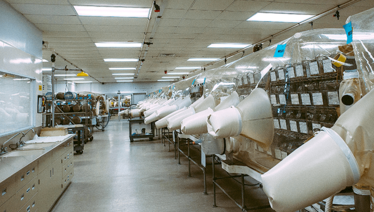The pre-clinical mouse model is an essential part of many translational medicine journeys, providing preliminary efficacy results that often determine if treatments are able to make the leap into clinical trials. With the growing availability of tools and techniques for genetic recombination, mouse models appear to allow access to increasingly relevant results... or do they? Some researchers argue that alternatives to animal models are overdue, others believe that they’re still the best pre-clinical option.
Can we gain more insight about the effectiveness of modern mouse models by ‘pulling back the curtain’ to see how these living pre-clinical pathways are created? Here, we speak with John Couse, portfolio director at Taconic Biosciences, to discuss how the shifting techniques and technologies in bioscience affect – and are affected by – mouse models.

Could you walk us through a typical mouse model process?
It begins when a customer liaises with a team of scientists to determine exactly the kind of traits they want to configure. A discussion on the best possible solution ensues; there are many various permutations and options for each particular need. Model generation takes a long time for a couple of reasons. Firstly, many pharma companies, biotechs, and even academics understand the model they’re looking for, but often don’t understand how they might get there. Secondly, extreme care is needed; a small misstep could lead to a minimum setback time of three to six months. Caution is all-important.
Once you’ve decided on the particular tool that you’re going to use, whether it’s CRISPR, homologous recombination, targeted transgenic, or something else, the process becomes more straightforward.
When you get down to designing a model to meet a customer’s specifications, it’s actually a relatively predictable process; the DNA level of the procedure, once underway, can be generally quite smooth, but the complexity can soon ramp back up.
Overall, it can be a lengthy process, with initial model generation taking 6–18 months, and the breeding portion taking an additional 9–24 months.
When breeding a genetically engineered mouse model, in many cases – at least for us – it’s the first time that they’ve been generated, so they are absolutely novel models. There’s no option to go back into the literature and say “this animal’s going to behave this way”, so the breeding and production portion of the process becomes a lot more unpredictable. Though our scientists are hugely knowledgeable and have seen just about every possible problem, even their combined expertise can’t predict every downstream permutation during breeding, so there is a little trepidation at that stage.
There are clear difficulties when translating mouse model results to humans...
In the end, they are only mice. Even rats, which are arguably physiologically closer to humans, are far from the ideal scenario. I think difficulty in translation will always exist, and the gap between the model you’re using and how you want to apply the data to improve and impact human health is always going to be relatively large.
Despite that gap, I think it’s certainly easier to translate mouse models to clinically relevant results than it is to convert in vitro data. In the last 10 years, the field has really taken huge strides to develop models that decrease the disparity, such as the generation of humanized mice – cases where we’re able to put large human genomic inserts into the mouse genome, while simultaneously knocking out the endogenous mouse locus. And when you start to develop animals that have multiple insertions of human genes, your model presumably becomes even more predictable of human physiology. But again, it is just a mouse model so there are limitations on how many – and which – human gene inserts you can feasibly include. Overall, I think the ultimate goal for any scientist working with pre-clinical models is to close the gap as much as possible.
Some say mouse models are outdated because of that gap. What’s your view?
Although I don’t agree, I can understand the argument. But with the constraints of time, budget, and resources, it is tempting to focus on in vitro tools only and avoid the use of rodent models. However, the limitations of in vitro tools are as obvious as those related to mouse models.
Right now, at our disposal we have in vitro and in vivo tools via CRISPR, homologous recombination, organ-on-chip devices and more. They all have their advantages and disadvantages, but being able to access all those tools is a definite benefit.
A researcher may argue that organ-on-chip has advanced away from animal models in certain fields – for example, toxicology – and I’d tend to agree. But when you start to move into other therapeutic areas that require a more physiological system, such as endocrinology, it’s very difficult to mimic within a chip. The disadvantages are even more evident when looking at the fields of behavior and neuroscience, because what you can’t necessarily do on a chip is look at the developmental and activational roles of genes – something that is much more attainable in an animal model.
Would I say the mouse is outdated? No. Would I say that there are limitations on the use of mice? Absolutely. But again, there are limitations on every tool when viewed in isolation.
On the other side, mouse models are relatively easy to produce. We understand the mouse better than any other laboratory animal model when it comes to genetic engineering – especially using homologous recombination – and it’s relatively inexpensive, compared with other animal models. So whether the mouse model is outdated is not necessarily relevant. Despite one’s view here, we should always be searching for better or complementary alternative solutions to generate better translational data. Maybe that lies with another animal model – or something else entirely. But until we get there, I think a mouse model is one of the best tools in a scientist’s arsenal.
What is the most exciting development in the pre-clinical research space?
There’s a lot of excitement about CRISPR/Cas-9, and I think it’s absolutely warranted. The technology is really quite amazing, both in its simplicity and its power – which I don’t think we have a full understanding of yet.
In regards to CRISPR’s application in research, it allows the potential to quickly mimic certain human diseases, especially the rare ones, in mice and rats. Human conditions that we believe are attributed to specific point mutations in human genes. In the past, these disease models were less often generated because of the difficulty and expense of trying to create them through homologous recombination. But CRISPR is specifically adept at producing these single point mutations quickly and inexpensively, allowing for recapitulation of rare diseases of genetic cause.
The advantages become especially clear when you start to see that these models can be applicable and affordable to the academic community. And when you start to give the larger scientific community access to a model of one particular disease, it’s amazing what can happen in terms of improving our understanding over a very short period of time. As soon as we’re able to harness the power of that technology, I think we might see an explosion in the development of these models.

Profile: John Couse
From a research standpoint, I grew up at NIH, as I had the opportunity of staying within the same field and laboratory for almost 18 years. It was a wonderful experience where I carried out basic research, but after all that time I reached a point in my career where I wanted new challenges and growth opportunities. I wanted to see a different part of science and how it applied to medicine and human health – to see how it was applied towards drug delivery, which led me to Taconic.
As portfolio director of Taconic’s custom scientific services, I essentially lead the services focused around generation of genetically engineering mouse models from the initial idea and conception, all the way through to breeding and generation of study cohorts that will eventually feed a pipeline of research for those models.
John Couse is portfolio director of custom scientific services at Taconic Biosciences.
- K Possin et al., “Lost in Translation”, The Translational Scientist, 5, 18–23 (2016). Available at: bit.ly/1UjqEgc.
- C Barker, “Animal Alternatives”, The Translational Scientist, 1, 38–39 (2016). Available at: bit.ly/2p9jqqT.
- B Williams, S Mackay, “An End to Animal Testing is Not Yet in Sight”, The Translational Scientist, Mar17 (2017). Available at: bit.ly/2nyrtK6.
My fascination with science, gaming, and writing led to my studying biology at university, while simultaneously working as an online games journalist. After university, I travelled across Europe, working on a novel and developing a game, before finding my way to Texere. As Associate Editor, I’m evolving my loves of science and writing, while continuing to pursue my passion for gaming and creative writing in a personal capacity.















